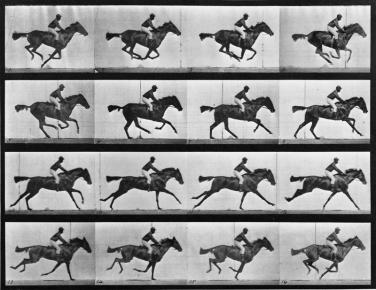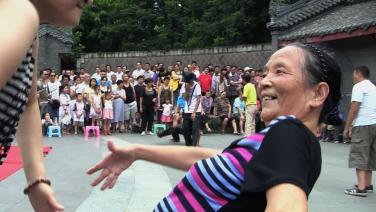This is a review of the history of cinema and its relationship with the concept of movement: whether in its early days with the physical, slapstick comedy of silent film; or in its historical relationship with sport; or in the way in which the camera and its movement – from the travelling shot to the long take – can define a work.


This is the famous story of the flying horse, which took place in 1872 in California. A group of horse racing enthusiasts maintained that during the galloping of the horse, there was a moment when its legs did not touch the ground. Another group of fans believed the opposite, so the first group commissioned the photographer Eadweard Muybridge to try to capture the movement of a galloping horse with his camera. The experiment was called The horse in motion (1878) and showed that the horse did indeed remain in the air for a few thousandths of a second. His subsequent photographic study of movement, a seminal work in the history of photography and a key moment in the birth of cinema, was called The Human and Animal Locomotion.
This experiment, and the very etymology of the word cinematograph – from the Greek kinema (movement) and graphe (writing) – has been our inspiration for a film season associated with the programme Ariketak: the second breath, which will take place in Tabakalera throughout the 2018-2019 biennium. It will involve a review of the history of cinema and its relationship with the concept of movement: whether in its early days with the physical, slapstick comedy of silent film; or in its historical relationship with sport; or in the way in which the camera and its movement – from the travelling shot to the long take – can define a work.
Ready, steady ... Go! Galloping bodies. Locomotion.
15 June, Friday, 20:00 (49’)
Making a living, Henry Lehrman, USA, 1914, 12’
Let’s go back to the very beginnings: this is Charlie Chaplin’s first film appearance, when he was not yet “The Tramp”, when the rules of what would later be known as silent comedy were still being defined; at the birth of slapstick, physical and knockabout humour, the gag, races and chases, etc. In this case, Chaplin pretends to be a reporter and the chaos typical his character soon ensues.
Kid auto races at Venice, Henry Lehrman, USA, 1914, 6’
Here we do see the first appearance of the “The Tramp”, the iconic vagabond created by Charlie Chaplin: his gestures, twitches, clothing, walking stick and sense of rhythm.
The Champion, Charles Chaplin, USA, 1915, 31'
If ballet and boxing ever had anything in common, Chaplin and his impossible moves in the ring demonstrate them here. It all begins when Chaplin the tramp and his dog find a horseshoe in the door to a gym and decide to try their luck in a fight against the champion Bob Uppercut.
June 24, Sunday, 19:00
People’s Park, J.P. Sniadecki and Libbie Cohn, AEB, 2012, 78', DCP
This film is like going for a walk: a single long take lasting for 78 minutes takes us through the popular park of Chengdu, in the province of Sichuan (China). There are people who walk, eat, dance, talk, sing, write, practice tai chi, observe and are observed. We are therefore presented with a film of rhythms, of pure movement: the movement of those who film and that of those who are filmed. The triangle closes, of course, in the cinema, with the public observing, inhabiting and walking through the images, living this block of space-time filmed one afternoon six years ago and now – thanks to the act of recording it at the time, and to the act of reproducing it now – brought back to life. Jury Prize at the Ann Arbor Film Festival (Michigan), 2013.
